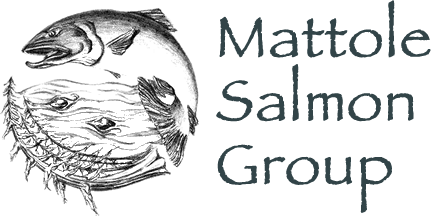Fisheries
The Mattole Salmon Group has conducted annual fisheries population monitoring since 1981. The goal of our fisheries monitoring programs is to determine where on the road to recovery of self-sustaining salmon runs we currently reside, document long term population status and trends, and help inform us where new restoration projects would be best directed. In addition to population status and needs, fisheries monitoring provides pre- and post-project effectiveness monitoring of our restoration projects. Currently active fisheries monitoring programs include spawner surveys, juvenile salmonid dives, and the Summer Steelhead Dive.
Spawner surveys provide data on the distribution and relative abundance of live salmon spawners, carcasses, and redds (spawning nests) in key tributaries and selected mainstem reaches. Surveys are conducted by a resident network of trained volunteers and paid personnel by wading, canoeing or snorkeling specified stream segments one or more times during the salmon spawning season. Surveys are generally conducted from November through late January. Data are used as an indicator of changes or trends in salmon escapement, and for evaluation of progress toward restoration goals. Since the 2011-12 season, the MSG has conducted surveys utilizing the California Department of Fish and Game (DFG) Mattole Sampling Frame Design (Garwood and Ricker 2008) and GRTS (Generalized Random Tesselation Stratified) random draw for reach selection as well as the DFG protocol for field procedures (Gallagher et al. 2007). This allows Mattole spawner surveys to remain consistent with other watersheds in California Department of Fish and Wildlife (CDFW) and NOAA Fisheries’ California Coastal Salmonid Population Monitoring plan (CMP) (Adams et al. 2011), as well as provide statistically valid population estimates for our Chinook and coho salmon populations.
Juvenile dives indicate juvenile salmonid distribution in the Mattole Watershed by using snorkel surveys to identify presence/absence of juvenile salmonid species in designated reaches. Prior to 2013, dive surveys were conducted at temperature monitoring locations in conjunction with placement and retrieval of temperature monitoring devices. Our snorkel surveys followed a “modified 10-pool protocol” for determining presence/absence of juvenile coho Salmon, as employed by the California Department of Fish and Wildlife (Preston et al. 2002). Since 2013, the MSG has used a dive protocol recently adopted by DFW as part of their Coastal Monitoring Plan. Survey reaches are the same as spawner survey reaches. Units to be surveyed are pools that meet specific depth, temperature and (sometimes) cover requirements. Every other pool in a reach is snorkeled (double-pass with independent counts).
Since 1996, the Mattole Summer Steelhead Dive has been the primary source of information and monitoring of Mattole River summer steelhead. Each year, MSG surveyors and volunteers snorkel the Mattole River and sections of two major tributaries to provide a census count of adult summer steelhead and “half-pounders” and identify their distribution. Additionally, the survey provides information on distribution of juvenile salmonids, other species of interest, cool-water habitat and potential restoration sites throughout the mainstem Mattole.
References:
Adams, P. B., L. B. Boydstun, et al. 2011. California coastal salmonid population monitoring: strategy, design, and methods. CDFG. Fish Bulletin 180. 82 p.
Gallagher, S.P., P.K.J. Hahn, and D.H. Johnson. 2007. Redd counts, pg. 197-234 in D.H. Johnson, B.M. Shrier, J.S. O’Neal, J.A. Knutzen, X. Augerot, T.A. O’Neil, and T.N. Pearsons. Salmonid field protocols handbook. American Fisheries Society, Bethesda, Maryland.
Garwood, J., and S. Ricker 2008. Mattole basin adult salmonid spawner survey frame design. California Department of Fish & Game, Arcata, CA.
Preston, L., M. Gilroy, and B. Jong. 2002. Coho Salmon presence/absence modified ten-pool survey protocol. California Department of Fish and Game Northern California – North Coast Region.
